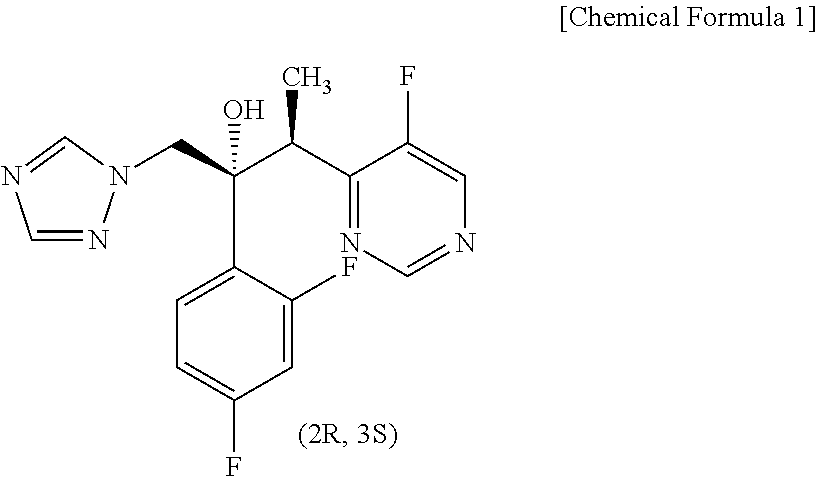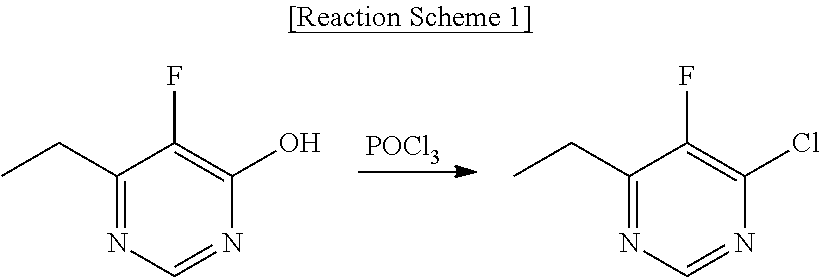Process for preparing voriconazole by using new intermediates
- Summary
- Abstract
- Description
- Claims
- Application Information
AI Technical Summary
Benefits of technology
Problems solved by technology
Method used
Image
Examples
example 1
Preparation of 2-(3,5-dibromo-1H-1,2,4-triazol-1-yl)-1-(2,4-difluorophenyl)ethan-1-one
[0049]First, 43.7 g of 3,5-dibromo-1H-1,2,4-triazole is introduced into 200 mL of tetrahydrofuran (THF), the resultant mixture is agitated, and 40.4 g of 2-chloro-2,4-difluoroacetophenone is further introduced thereto. Next, 36.3 g of potassium carbonate is introduced to the reaction mixture and the resultant mixture is agitated for 7 hours at room temperature. After the completion of the reaction, the reaction mixture is filtered, washed with 100 mL of tetrahydrofuran (THF), and concentrated at room temperature. Then, 437 mL of purified water is introduced so that the crystals are slurried, followed by filtering. The filtered crystals are reslurried in 175 mL of isopropanol and filtered again. The crystals are washed with 44 mL of isopropanol and dried with hot air at 50° C. to obtain 63.8 g of the title compound as a white solid (yield 87%, purity 99.2%, HPLC, detected at a wavelength of 256 nm, ...
example 2
Preparation of 6-ethyl-4-fluoropyrimidin-4-yl methanesulfonate
[0051]First, 100 g of 6-ethyl-5-fluoropyrimidin-4-ol is introduced to 1000 mL of methylene chloride (MC), followed by agitation. Next, 196 mL of triethyl amine is introduced thereto at room temperature and 59.9 mL of methanesulfonyl chloride is added dropwise thereto. After the reaction mixture is agitated for 5 hours at room temperature, the reaction mixture is cooled to 5° C. and 126.75 g of acetic acid is introduced thereto. The reaction mixture is washed twice with 1000 mL of purified water, and then the organic layer is dried over magnesium sulfate, filtered and concentrated under reduced pressure to obtain 153.4 g of the title compound (yield 99%, purity 93.5%, HPLC, detected at a wavelength of 256 nm, 18C 4.6×250 mm, mobile phase 60% ACN, flow rate 1 mL / min).
[0052]1H-NMR (200 MHz, CDCl3) δ (ppm): 8.67(1H), 3.60(3H), 2.97-2.89(2H), 1.35(3H).
example 3
Preparation of 6-(1-bromoethyl)-5-fluoropyrimidin-4-yl methanesulfonate
[0053]First, 153.4 g of 6-ethyl-4-fluoropyrimidin-4-yl methanesulfonate is dissolved into 100 mL of methylene chloride (MC), followed by agitation. Next, 186 g of N-bromosuccinimide (NBS) and 5.7 g of azobisisobutyronitrile (AIBN) are introduced thereto at room temperature. The reaction mixture is warmed to 45-50° C. and agitated for 12 hours. After the completion of the reaction, 1000 mL of purified water is introduced to the reaction mixture, followed by washing. Then, 66.2 g of sodium metabisulfite is introduced to and dissolved completely in 1000 mL of purified water to provide a solution, which, in turn, is introduced to the reaction mixture for washing. After that, 1000 mL of 5% sodium bicarbonate is introduced and the reaction mixture is washed. Then, the organic layer is dried over magnesium sulfate, filtered and concentrated under reduced pressure to obtain 218.3 g of the title compound (yield 104.7%, pu...
PUM
 Login to View More
Login to View More Abstract
Description
Claims
Application Information
 Login to View More
Login to View More - R&D
- Intellectual Property
- Life Sciences
- Materials
- Tech Scout
- Unparalleled Data Quality
- Higher Quality Content
- 60% Fewer Hallucinations
Browse by: Latest US Patents, China's latest patents, Technical Efficacy Thesaurus, Application Domain, Technology Topic, Popular Technical Reports.
© 2025 PatSnap. All rights reserved.Legal|Privacy policy|Modern Slavery Act Transparency Statement|Sitemap|About US| Contact US: help@patsnap.com



